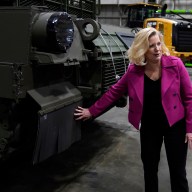Even in the neatest of homes, children’s bedrooms are magnets for clutter. These rooms also tend to be the smallest in the house, so managing clutter can be tough. Toys and clothing must be organized and out of the way, but still visible and accessible. “Kids grow out of things every 10 minutes,” says interior designer Christina Murphy.
“So the more stuff can be out in open, the better.”
Here are five ideas for taming kids’ clutter from Murphy and two other designers, Fawn Galli and Katie Stassi, all named to domino magazine’s “Ten Decorators on the Verge” list this year:
>> Think transparent
Clear, stackable plastic bins in all sizes are great for toys and clothing, says Stassi. Kids can see inside so they won’t need to dump out several bins to find a favourite toy.
If you prefer baskets or bins that aren’t transparent, but still want to be clear on what’s inside, Galli suggests labelling them with the name and picture of the contents (blocks, Barbies, etc.). Kids will “learn through image and spelling where to put things,” she says.
>> Go vertical
“Hooks are great with kids,” says Murphy, “because they can reach them to hang towels or their own coat, and you’ll get them in the habit of picking stuff up off the floor.” Wall shelves keep fragile items and keepsakes visible but safe, says Stassi. They’re also good for storing tiny toys out of reach of younger siblings (small, clear bins come in handy here).
>> Find furniture that does double duty
“A trunk at the foot of the bed is a great one,” Murphy says, because it offers storage and seating. “You can get a plain white trunk at Ikea and then decorate it.
Depending on the kids’ ages, they can get involved, just putting stickers on it or maybe using stencils if they’re older.” Kids can reach the trunk or bench, so they can easily take objects out or help put them away.
>> Think outside the drawer
Go tropical with a hammock, says Murphy. “There are varying degrees of hammocks, cheap ones without the big bar across, just big enough to be holding toys and maybe one kid. It can vary based on the space you have.”
At the end of each day, stray toys on the floor can be gathered up and tossed on the hammock. For a smaller, modified version: Drape a large length of colourful fabric diagonally between two walls at one corner of the room, knotting the ends and securing them on hooks.
Use it to pile up plush toys or other bulky-but-light things. Hung a metre or so above the floor, it serves as a canopy for the play space underneath.
>> Eliminate the extras
All three designers mentioned the importance of removing clothes and toys as kids outgrow them. Every six to eight weeks, search the room for items to donate or store in a garage or basement for younger siblings to use later.
Talk to your kids about the importance of donating rarely used things to a local children’s hospital or shelter, says Stassi, and get them involved in the process.
Of course, clutter can reach critical mass when kids don’t want to part with anything.
“It can get so out of control,” says Murphy. “Parents have to sometimes sneak stuff out if you can … If they don’t see it leave, they may never miss it.”
















